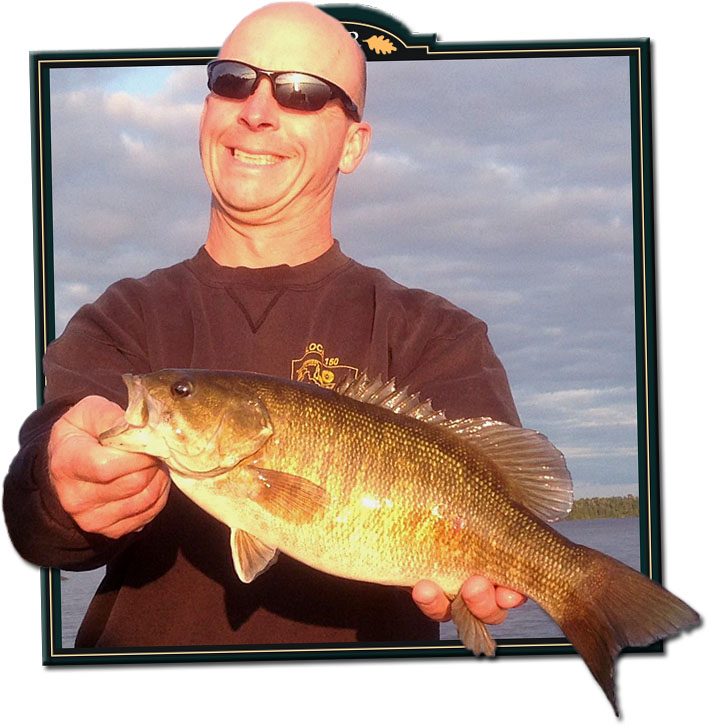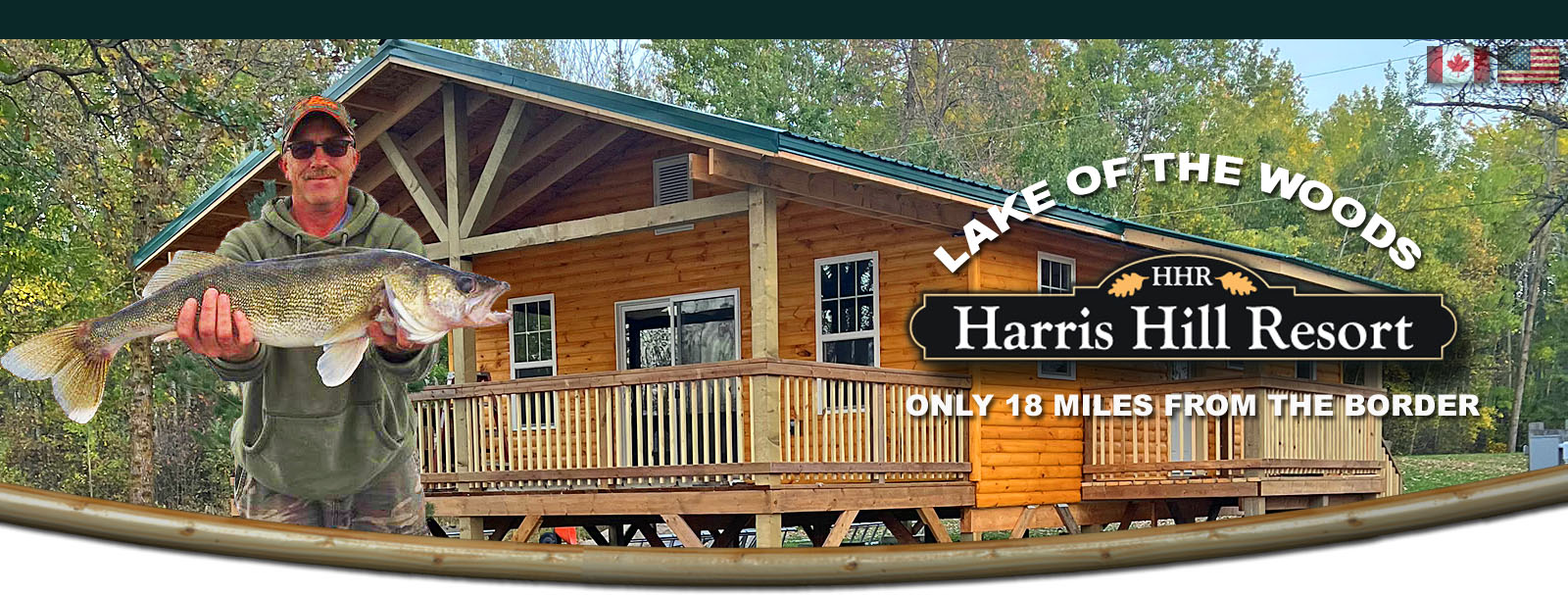Lake of the Woods Smallmouth Bass Fishing

Smallmouth Bass are an extremely hard fighting fish and show great acrobatics as they are known for jumping as soon as they are hooked. When they are not flying into the air, they are fighting straight down with an intensity that is unrivaled by any other fresh-water fish their size. They truly are a magnificent fish to catch.
Their primary food is bugs, minnows and crayfish. Their feeding behavior is directly related to their size. Smaller bass in the one-half to two pound range generally travel along the shore in hunting packs and can have up to a hundred fish in these packs. They will swim along a shore that is facing the waves because the waves are washing microorganisms into shore and the bass know the minnows will follow the wind into feed. If you come across one of the hunting packs you can catch ten to twenty bass in an hour. They will mostly be smaller but it's still a lot of fun.
When the Smallmouth Bass get to an age where they exceed two pounds they leave the hunting packs of smaller bass and tend to swim around in schools of five or six fish. They still follow the shoreline like the other fish though. If you catch a 17" three pound Smallmouth Bass, odds are there a few more in the same area. The really large Smallmouth Bass in the four to six pound range usually travel alone or in mating pairs. They will stake out a prime territory and claim it, as they are not nomadic like the smaller bass. They will also chase other bass out of their territory. Big bass are big because they are smart. Understanding this is important because if you go to a spot that seems perfect and you do not catch anything, keep trying that spot every day and keep trying different baits and most of all, be stealthy. There are a lot of Smallmouth Bass up to 21", in the four to six pound range, in Lake of the Woods. It is getting more common that seven-pounder and bigger get caught, but fish that big are harder to catch. Ontario Master Angler Awards reward fishermen for Smallmouth Bass 17" & over.
Generally speaking if you were specifically targeting Smallmouth Bass you may be able to catch up to 10 or more Bass in a day. Then there are always those days when the Bass are hitting like crazy and you can catch well over twenty. During the week of fishing you should catch a few outstanding fish over six & seven pounds. Smallmouth Bass season opens July 1, and mid July to mid September is the best time for Smallmouth Bass.
Smallmouth Bass Baits & Points to Ponder
Smallmouth Bass go deep in the winter. Nitrogen and methane float up from the bottom of the lake and get trapped under the ice and become concentrated in the shallows. After the spring melt the bass take a long time to make the depth adjustment and come shallow. When they do come shallow they are more concerned with spawning and not really feeding. By mid July the vast majority of Bass have started their normal feeding patterns. The Bass seem either more abundant or easier to catch in the fall, although some nice 19-21" Smallmouth Bass are caught right in the Bay in front of the resort earlier in the season.

Lures: Smallmouth Bass will hit both submerged and top water baits. Smallmouth Bass can be funny though. Some days they are very aggressive and go after everything and other days they will only hit live bait or nothing at all. Small spinnerbaits, jerkbaits, flatfish, spinners, Rapalas, Thundersticks, tub jigs, rubber worms or plain jigs all work well. On the surface you can use small top-water baits such as poppers, jitterbugs and spooks.
Senko Worms: The hottest bait for Smallmouth Bass in the last few years has been Yamamoto Senko Worms. They are getting very popular. If you buy some get the unscented. Fish in clean northern lakes do not like scented baits. However they do like salted baits. Pumpkin seed and green with gold flakes have proven to be super hot colors. Black, white and bubble gun pink have also been producing well. They come in many sizes; Some fisherpersons like the small 2" while others like the bigger 4" and 5".
Colors: With Smallmouth Bass you have to keep changing colors to see what they are hitting on for that day. Some days they like neutral colors such as black-&-silver or blue-&-silver. Some days they like really bright colors and patterns such as chartreuse or firetiger. Some days they will only go after purple or pink. You have to keep changing your lures and trying new things until you find what they are hitting that day.
Live Bait: Some days the Smallmouth Bass are very lazy and just don't want to hit baits. You can still entice them with a Minnow or big fat worm. The best thing to do is throw your bait on a hook and let it sink to the bottom. Then slowly drag your lure over the rocks and make it look like a leach. It is illegal in Ontario to use Frogs or Crayfish for bait. The law was set in place to stop the spread of the Rusty Crayfish, which has devastated many lakes in the south. Smallmouth Bass always love live minnows.
Fly-fishing: Fly-fishing for Smallmouth Bass is getting more and more popular. What you want to do is find a rocky point with wind and waves hitting the point on one side. Toss your fly on the windy side and let the current whip your fly around the point into calmer water. Since fly-fishing for Smallmouth Bass is so new, most people just use pike flies such as the Barry Reynolds Pike Bunny, Rabbit Strip Pike Bunny, Mcmurderer, Mickey Finn Streamer and the English Pikefly. There are other flies that would appear to be good for Bass like the Softshell Crayfish Fly, Dancing Frog Fly, Pencil Popper Fly and the Hard Foam Popper Fly.
Bass Depth & Location: You will find Smallmouth Bass everywhere. Often people catch them deeper while Walleye fishing or in the thick weeds while casting for Northern Pike. Generally their favorite place is off rocky shorelines that face waves coming from the prevailing winds and off rocky points and shoals. Waves not only produce oxygen, they wash away silt and sediments making a better environment for Crayfish to burrow under rocks and Crayfish are the Smallmouth Bass' favorite food. That is some reasons they love the 103 Reef close to the resort. They also love the waters between Gooseneck Island & Bigsby Island.
Wave action will determine how deep the Bass are. With waves up to six or seven inches Smallmouth Bass with be right close to shore in shallow water. As the waves get bigger they will move deeper. It is surmised that oscillation caused by big waves is annoying to them because they can't stabilize themselves at the entrance of a Crayfish burrow. If there is no wind at all the Bass will also go deep to hide from the sun. Always try casting at both the windy and the calm side of the point with shallow running lures. If the waves are big or there are no waves at all the Bass could be in the darker water down fifteen to twenty feet. When the water has been still for days and the sun is really bright, Smallmouth Bass can head down into the water depths and hang around sunken reefs and ledges next to deep drop-offs. In this case sinking tube jigs down to them is a very popular method.
Whether you are new to Smallmouth Bass fishing or a seasoned pro, you will love staying at Harris Hill Resort because we have a high population of fish and more Smallmouth Bass structure than you could fish in a year. The Bass possibilities are endless. Lake of the Woods is one of the few lakes in Northwestern Ontario that also has largemouth Bass, and the population is growing every year.
 Black Bear Hunt Photos
Whitetail Deer Hunting - Overview
Rifle: Non-Resident Deer Hunt
Bow: Non-Resident Deer Hunt
Resident Deer Hunt
Resident Baited Deer Hunt
Black Bear Hunt Photos
Whitetail Deer Hunting - Overview
Rifle: Non-Resident Deer Hunt
Bow: Non-Resident Deer Hunt
Resident Deer Hunt
Resident Baited Deer Hunt
 Whitetail Deer Hunt Photos
Wolf Hunting
Duck & Goose Hunting
Grouse Hunting
Whitetail Deer Hunt Photos
Wolf Hunting
Duck & Goose Hunting
Grouse Hunting
 Black Bear Hunt Photos
Whitetail Deer Hunting - Overview
Rifle: Non-Resident Deer Hunt
Bow: Non-Resident Deer Hunt
Resident Deer Hunt
Resident Baited Deer Hunt
Black Bear Hunt Photos
Whitetail Deer Hunting - Overview
Rifle: Non-Resident Deer Hunt
Bow: Non-Resident Deer Hunt
Resident Deer Hunt
Resident Baited Deer Hunt
 Whitetail Deer Hunt Photos
Wolf Hunting
Duck & Goose Hunting
Grouse Hunting
Whitetail Deer Hunt Photos
Wolf Hunting
Duck & Goose Hunting
Grouse Hunting








